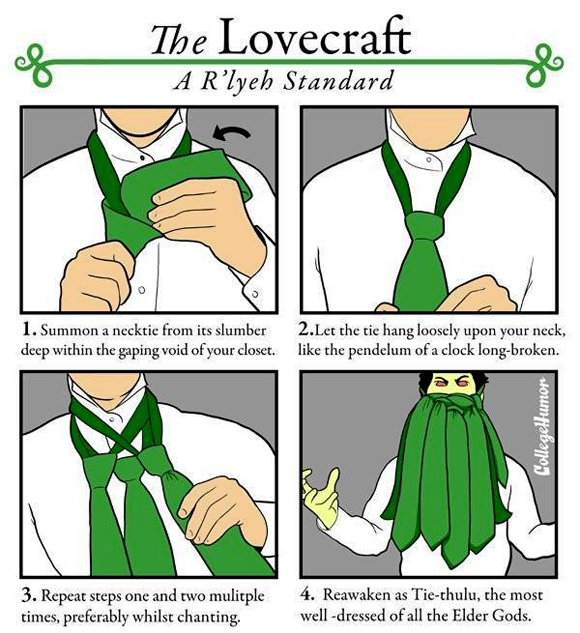the lovecraft tie
Above these apparent hieroglyphics was a figure of evident pictorial intent, though its impressionistic execution forbade a very clear idea of its nature. It seemed to be a sort of monster, or symbol representing a monster, of a form which only a diseased fancy could conceive. If I say that my somewhat extravagant imagination yielded simultaneous pictures of an octopus, a dragon, and a human caricature, I shall not be unfaithful to the spirit of the thing. A pulpy, tentacled head surmounted a grotesque and scaly body with rudimentary wings; but it was the general outline of the whole which made it most shockingly frightful. Behind the figure was a vague suggestions of a Cyclopean architectural background.
The writing accompanying this oddity was, aside from a stack of press cuttings, in Professor Angell’s most recent hand; and made no pretense to literary style. What seemed to be the main document was headed “CTHULHU CULT” in characters painstakingly printed to avoid the erroneous reading of a word so unheard-of. This manuscript was divided into two sections, the first of which was headed “1925 – Dream and Dream Work of H.A. Wilcox, 7 Thomas St., Providence, R. I.”, and the second, “Narrative of Inspector John R. Legrasse, 121 Bienville St., New Orleans, La., at 1908 A. A. S. Mtg. – Notes on Same, & Prof. Webb’s Acct.” The other manuscript papers were brief notes, some of them accounts of the queer dreams of different persons, some of them citations from theosophical books and magazines (notably W. Scott-Elliot’s Atlantis and the Lost Lemuria), and the rest comments on long-surviving secret societies and hidden cults, with references to passages in such mythological and anthropological source-books as Frazer’s Golden Bough and Miss Murray’s Witch-Cult in Western Europe. The cuttings largely alluded to outré mental illness and outbreaks of group folly or mania in the spring of 1925. (Lovecraft 1928 [1926])
So, here is the tie between Cthulhu, the sunken city of R’lyeh and anthropology … but that wasn’t my drift, instead:

See also ↵lovecraftian tintin.
the illustration at the top of the post is by ↑Michael Komarck (2006)


